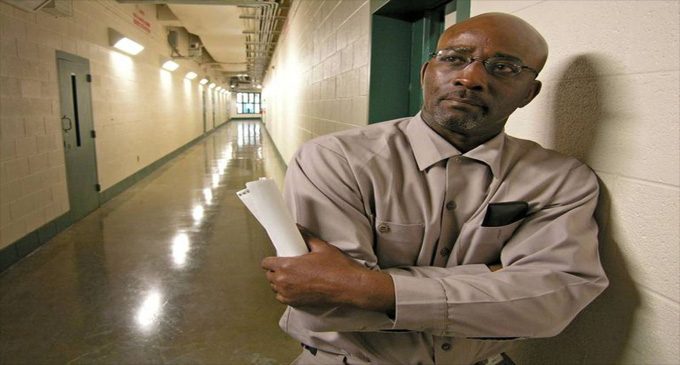Long’s innocence argued in Fourth Circuit Court of Appeals
Long has spent 44 years in prison for a crime he didn't commit. -Photo by Caitlin Penna

“When did justice leave the court?”
That was the question Judge James Wynn raised while listening to virtual arguments for the Fourth Circuit Court of Appeals, in the case of Ronnie Long v. Erik Hooks. Long, a native of Concord, has been in jail since 1976 for a crime he maintains he didn’t commit.
“When we look at these cases, I often wonder why there is so much zeal to not look at evidence and make that determination now. What is it about us that wants to prosecute and keep people in jail when we know evidence may exist that might lead to a different conclusion?” asked Judge Wynn rhetorically during the hearing last week.
When he was only 19 years old, Long, who is black, was charged with the assault and rape of a white woman in her home on April 25, 1976. According to police reports, the victim was the widow of a top executive at Cannon Mills, a major textile company and employer in the area. The victim described her attacker as a “yellow-looking African American,” wearing a leather jacket, a toboggan, and gloves. She told police her attacker came through an open window before pressing a knife against her neck and ripping her clothes off.
After she was unable to pick her attacker out of a lineup, two weeks after the assault, investigators with the Concord Police Department took the victim to the courthouse and told her that her attacker may or may not be in the courtroom, and asked her to identify anyone who looked “familiar.”
Long was in the courtroom to settle a minor trespassing charge, but as soon as he stood up wearing a leather jacket, the victim identified him as her attacker. She later picked Long’s photo out of a lineup where he was the only person wearing a leather jacket.
Despite having an alibi that placed him elsewhere at the time of the assault, and no physical evidence connecting him to the crime, on Oct. 1, 1976, Long was sentenced to serve 80 years in prison.
In his opening arguments, Jamie Lau, executive director of the Duke Law Wrongful Convictions Clinic, who has been working on Long’s case since 2016, said the Concord Police Department deliberately suppressed evidence that proved Long’s innocence and pointed to another suspect. Lau said the Concord Police Department’s efforts to frame Long included the creation of a false police report and testifying falsely about the evidence they found at the crime scene.
“Suppressing the evidence prevented Long from presenting affirmative exculpatory evidence demonstrating that someone else was the assailant, not Mr. Long,” Lau continued. “A suspect hair was collected from the scene, fingerprints were collected from the scene, matches were collected from the scene. They were all tested and none of them were similar to Long. There were 43 fingerprints collected that didn’t match Long or the victim, pointing to someone else.”
The 43 fingerprints Lau mentioned weren’t disclosed until after a N.C. State Supreme Court hearing in 2008. Case files also show that the hair collected from the scene was determined to be “reddish” in color and from someone of “negroid” or “Mongolian” decent that didn’t match Long, but was consistent with the victim’s description of her attacker. There is also biological evidence that proves Long’s innocence. According to Lau, the biological evidence was taken from the victim on the night she was assaulted, transferred to Sgt. Walter Lee, formally of the Concord Police Department, and was never seen again.
“The record of that evidence stops there. It’s nowhere in the files of the Concord Police Department that they had biological evidence in this case and the only reason Long knows biological evidence exists in this case is because the Cabarrus Memorial Hospital still has the transfer to the Concord Police Department,” Lau said.
When addressing the panel of 15 judges that make up the Fourth Circuit Court of Appeals, the state asked the court to uphold Long’s conviction. Philip Rubin, state assistant attorney general, argued that the victim, who has since died, identified Long in the courtroom and in a photo lineup. Rubin also said the leather jacket, toboggan, and gloves found in Long’s car matched what the victim said her attacker was wearing. He also mentioned a shoe print taken from the crime scene was similar to a pair of shoes Long owned.
After listening to the evidence presented by Lau and Rubin, Judge Paul Niemeyer and Judge Harvey Wilkinson questioned if the Appeals Court had the power to make a ruling in the case. But Judge Wynn, who was born and raised in North Carolina, made it clear how he felt about the case and the need for a re-trial.
He said, “You have evidence here that prosecutors had evidence that clearly any defense council in the world, not only in 1976 but since the history of this country, would’ve wanted or needed and should’ve been supplied … and yet they did not provide it. …When we look at these circumstances, I just don’t understand why we wouldn’t take a look at it.
“We know what happened in 1976. It’s very difficult for the conscious to even accept that as an argument when it’s so simple; all we’re saying is look at the evidence. No one is making a determination today … just look at it, what’s the problem with that?” he continued. “When did justice leave the court? That’s the question – when did justice leave the process such that we let our rules blind us to the realities that we all can see?”
Now that the hearing is over, Long’s fate lies in the hands of the panel of judges who heard his case last week. No timetable has been set for a ruling in the case. It could take weeks or months before a decision is made.
















